|
written by: Angela Saenz and Eva Perry
On February 12th (2021), Dr. Zoe Getman-Pickering, who obtained her Ph.D. from Cornell University in 2020 and is currently a postdoctoral scientist working at George Washington University with John Lill, spoke in the Entomology Colloquium series about her research related to the tri-trophic interactions between plants, herbivorous insects, and arbuscular mycorrhizal fungi (referred to as mycorrhizal fungi, or mycorrhizae, hereafter). She described her work on the relationship between plants and mycorrhizal fungi, and the biotic and abiotic factors influencing this relationship. Written by: Mike Nan
Dr. Karen Hales is a Biology Professor at Davidson College who employs genetic tools with the fruit fly (Drosophila melanogaster) model to understand the molecular mechanisms of mitochondria function in cells. While past colloquium speakers have presented on the latest research in their lab, Dr. Hales addressed an even more pressing, teaching topic: Enhancing inclusivity in undergraduate science courses through careful wording of course-specific material concerning gender identity, disability, and race.
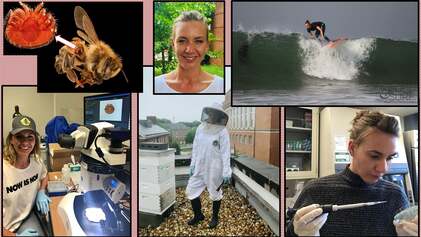 Krisztina Christmon is the current president of ESO and is a third year PhD student in the vanEngelsdorp Bee Lab studying the honey bee parasite Varroa destructor. You can find her either at the lab or by the microscope. If not, then she’s probably gone surfing! Krisztina is passionate about the host-parasite pathogen interactions. Follow the link to get an in depth look at her collaboration with the USDA. https://www.mdpi.com/1999-4915/12/4/374/xml written by: Demian Nunez and Madeline Potter
Neonicotinoids are most commonly known to the public as a class of chemicals responsible for widespread pollinator decline. To growers they are a cheap means of dealing with historically difficult soil pests and are heavily used throughout the United States as a preventative measure. Given their prevalence, are the benefits enough to justify their use? Recent University of Maryland (UMD) entomology graduate Dr. Aditi Dubey, Hamby Lab, addressed this question and more in her exit seminar, summarizing five and a half years of research. 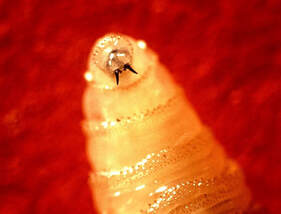 Figure 1. Screwworm larva (USDA - APHIS) Figure 1. Screwworm larva (USDA - APHIS) written by: Graham Stewart, Meghan McConnell, Tais Ribeiro On the past November 20th, Dr. John Welch, Liaison for Action Programs of International Services (APHIS) and co-recipient of the 2020 Scientist of the Year Award, brought to the Entomology colloquium his example of a successful entomological career outside of academia, sharing some of his adventures and the many roles he has occupied. Although Dr. Welch’s work has involved a variety of issues, over the years his main focus has been on eradication of the screwworm (Fig 1), Cochliomyia hominivorax (Diptera: Calliphoridae). The screwworm is a deadly, parasitic fly that feeds on the living tissues of warm-blooded animals. It has many nicknames, one being “man-eater”. It has been a problem for livestock and humans for decades, leading to major economic losses for farmers. Two entomologists Edward F. Knipling and Raymond C. Bushland, are known for pioneering successful eradication efforts through the Agriculture Research Service (ARS). They developed the sterile insect technique (SIT), a low dose of radiation to make the screwworms sterile. The flies are then raised in a lab and released in infested areas. These sterile males mate with the females and the eggs laid do not mature. Drainage ditches as valuable sources of spider diversity and abundance for adjacent croplands12/1/2020
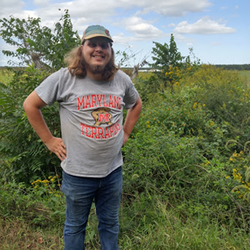 written by: Eva Perry and Lindsay Barranco At the beginning of his Entomology Department exit seminar presentation, graduate student Dylan Kutz asked his zoom-viewing audience “Who cares about spiders?” and “Why study drainage ditches?” – two questions that immediately grabbed everyone’s attention. Over the past three years Dylan has proven himself to be an adventurous and fearless researcher – sampling agricultural cropland drainage ditches for spiders in order to ascertain how they may facilitate natural pest management practices by supporting spider populations. written by: Darsy Smith & Veronica Yurchak
Dr. Galen Dively, a Professor Emeritus in the Department of Entomology at the University of Maryland, has become a leading figure in the effort to monitor and mitigate resistance development to genetically modified Bt corn, primarily addressing the very destructive corn earworm. At this week’s colloquium, Dr. Dively presented on his work designing a new approach for monitoring insect resistance in Bt corn, as well as how this approach is changing the way genetically modified crop technologies are regulated by the EPA. Many people are fascinated about the diversity in nature, some are attracted by cichlids with various colors, others were allured by butterflies with different patterns. Katherine Taylor, a new Post-doc in the Fritz lab, was interested in the diversity of the lacewing mating songs.
For nearly the last two decades, STEM educators, particularly those in biology, have been moving toward a more active learning model for undergraduate courses. Dr. Marcia Shofner has been at the forefront of that effort at University of Maryland. Dr. Shofner is a Senior Lecturer in the Entomology Department, teaching several sections per year of Ecology and Evolution. Not only is this course often an early undergraduate’s first introduction to college biology, but it is often a Graduate Teaching Assistant’s first foray into teaching as well. At this week’s colloquium, Dr. Shofner shared a “peer through the lens” into designing and implementing an active learning course with the Entomology community.
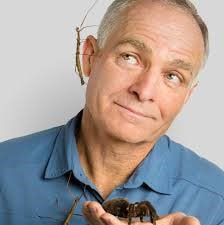 Mike Raupp Mike Raupp In the spring of 2004, millions of 17-year cicadas emerged from the ground. They crawled over trees, houses, and cars. They molted leaving exoskeleton shells on every surface. Birds feasted. Squirrels gorged themselves. Newly planted trees suffered. Children tiptoed though carcasses on their way to school. Parents scraped goo off their car’s wheels. The air vibrated with the cacophonous sound of cicadas. Then they were gone. But next year they are coming back. Whether you anticipate it with dread or excitement, they are coming again. In his colloquium presentation to the UMD Entomology Department, Dr. Mike Raupp, an emeritus entomology professor at the University of Maryland, brought us up to speed on the coming emergence of periodical cicadas. The last time Brood X, the 17-year cicadas local to this area, emerged from the ground, entomologists were in heaven. Dr. Raupp gave numerous talks around the country even ending up on Jay Leno’s late-night show to teach about the fascinating insect. He explained how 17-year cicadas are a great opportunity to get people interested in bugs. Next year, they may be even more numerous due to recent habitat restorations and improved tree cover. 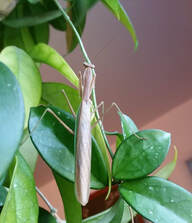 A mantis from UMD’s insect zoo at Todd Water’s apartment during lockdown (Photo credit: Todd Waters) A mantis from UMD’s insect zoo at Todd Water’s apartment during lockdown (Photo credit: Todd Waters) Written by: Maria Cramer, PhD student, Hamby Lab Seven months into the global COVID-19 pandemic, Dr. Leslie Pick, department head of entomology, kicked off the department’s fall colloquium series in a way that’s become familiar; she muted the audience, thanked everyone for coming, and shared her screen. Past colloquium speakers have talked about the latest research in entomology, but Dr. Pick talked about topics even more important: COVID-19 and racism. Addressing COVID, she took us back to March by reminding us that over a one-week period the department transitioned from normal research to working from home with severe research restrictions. When you’re working with live animals and cultures, however, this doesn’t mean hitting a pause button. The whole department mobilized to care for colonies of insects and live cultures on campus or bring them home. Bringing home wolf spiders, lady beetles, and mantises was a new adventure for many and even attracted the attention of Nature and NPR. 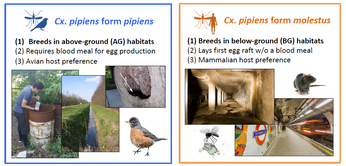 Figure 1: Cx. pipiens – one species with two bioforms: form pipiens and form molestus (image credit: Anna Noreuil). Figure 1: Cx. pipiens – one species with two bioforms: form pipiens and form molestus (image credit: Anna Noreuil). written by: Mike Nan, PhD student, St. Leger lab and Dylan Kutz, MS student, Lamp lab Anna Noreuil, an M.S. student in the Fritz Lab in the Department of Entomology at the University of Maryland, has been studying host-seeking behavior and differential chemosensory gene expression in above- and below-ground Culex pipiens for her master’s research. Cx. pipiens (Diptera: Culicidae) is a mosquito found in the northern regions of the U.S. and is also found in urban and suburban temperate areas around the world. Cx. pipiens is the primary vector of West Nile virus (WNV), a mosquito-borne disease that affects the nervous system, in the Northeastern US. Oddly, although there is only one species known as Cx. pipiens, two “bioforms” of the species exist which are morphologically indistinguishable but genetically, physiologically, and behaviorally different: “Cx. pipiens form pipiens” and “Cx. pipiens form molestus.” Cx. pipiens form pipiens differs from Cx. pipiens form molestus in three distinct ways: (1) it breeds in above-ground habitats, (2) it requires blood meals for egg production, and (3) it prefers avian hosts over humans (Figure 1). However, these two “bioforms” readily hybridize or crossbreed and as such they are both classified as the same species (Figure 2). Catching bugs isn’t just for entomologists: Inside the University of Maryland’s plant diagnostic lab3/23/2020
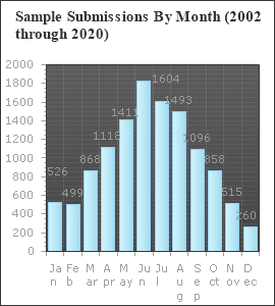 Fig. 1. Number of samples received by the UMD Plant Diagnostic Lab between 2002 and 2020. Graph kindly provided by Dr. Rane. Fig. 1. Number of samples received by the UMD Plant Diagnostic Lab between 2002 and 2020. Graph kindly provided by Dr. Rane. written by: Dongxu Chen, PhD student, Hawthorne lab and Katie Reding, PhD student, Pick lab Every gardener, farmer, or landscaper will at some point find some mysterious spots on their prized plants, or perhaps find that a random subset of their crop has wilted overnight. To anyone who’s not an expert, the pathogens causing these diseases can be hard to identify and seemingly impossible to control. Indeed, it can take much more than a trained eye to properly diagnose many plant diseases; often, axenic culture (growing only the organism of interest without contaminants) of the pathogen is required, and in some cases molecular tests are warranted. Dr. Karen Rane, the entomology department’s resident plant pathologist and this week’s colloquium speaker, uses all of these tools and more to handle the roughly 700-900 diseased plant samples her plant diagnostic lab receives each year (Fig. 1)*. written by: Maria Cramer, PhD student, Hamby Lab and Lindsay Barranco, MS student, vanEngelsdorp Lab
When you conduct research on urban pollinators, it’s impossible to ignore the way your research impacts people and the way people impact your research. This was the overarching message from Dr. Mary Gardiner who studies the ecology of urban greenspaces in Cleveland, Ohio. Over the past several decades, Cleveland has lost half its residents, resulting from protracted economic decline. Currently, population levels equal what existed in Cleveland in 1900, resulting at least in part from a steady rise in home foreclosures. The home foreclosures and resulting vacant lots from demolished homes have led to a major increase in greenspace. The city of Cleveland maintains these lots by mowing on a monthly basis which costs the city upwards of 3 million dollars per year. Dr. Gardiner wondered if the weedy and grassy spaces within Cleveland’s 30,000 vacant lots could provide valuable bee habitat. Would planting flowering plants, exotic or native, provide better habitat than what the vacant lots offered? Which species of bees might these green spaces attract? And importantly, could providing bee habitat help beautify demolished and vacant areas? Written by: Mike Nan, PhD student, St. Leger lab
Dr. Jian Duan, a Research Entomologist at USDA, is working on sustainable ways to manage the invasive emerald ash borer (EAB) through introduction and establishment of natural enemies (stingless wasps) from the pest’s native range. This approach, also termed as classical biological control in the literature, can lead to permanent or sustainable reductions of pest populations. Dr. Duan explained that there are four stages in the invasion of new environment by a non-native species: (1) Transport (Introduction), (2) Establishment (or colonization), (3) Spread, and (4) Impact. There are two possible outcomes at each stage that can lead to either failure or success in progression. 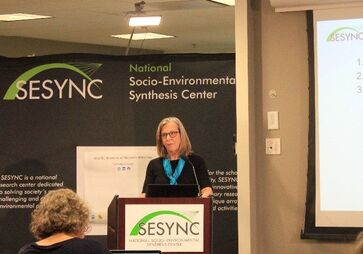 Dr. Margaret Palmer giving a presentation about SESYNC. Dr. Margaret Palmer giving a presentation about SESYNC. written by: Max Ferlauto, MS student, Burghardt Lab In this anthropogenic age, most natural, social, and economic systems are tightly linked. However, scholars studying these systems tend to be isolated by their respective disciplines. It is the role of the National Socio-Environmental Synthesis Center (SESYNC) to bridge this divide. SESYNC, located in Annapolis, MD, is one of four Synthesis Centers that have been funded by the National Science Foundation (NSF). Synthesis Centers facilitate team research to generate discoveries from existing data, addressing fundamental questions and leading to innovative solutions. What sets SESYNC apart from other Synthesis Centers is its focus on linking natural and social science together. The idea came about in 2010 at a small workshop during a discussion about the NSF’s call for a new Synthesis Center. Margaret Palmer, Bill Fagan – both professors at the University of Maryland, and Jonathan Kramer, the then director of the Maryland Sea Grant, decided that the new center needed to study socio-environmental not just ecological science. Palmer and Kramer, joined by ecological economist Jim Boyd, spent almost a year drafting the proposal. Their effort paid off and the NSF provided funding for SESYNC in 2011. What we don’t know could hurt us: the mystery of pesticide use and consequences for insects11/27/2019
written by: Maria Cramer, PhD student, Hamby Lab and Veronica Yurchak, PhD student, Hooks Lab
Dr. Maggie Douglas, an assistant professor from Dickinson College, managed to stump most of a room full of entomologists when she asked them if pesticide use in United States agriculture was going up or down over time. There were a few embarrassed laughs, but Douglas reassured everyone; “It’s a complicated question. There’s disagreement in the scientific community.” written by: Dylan Kutz, MS student, Lamp Lab
Whenever we see the words “genetically modified” in the news these days, they’re usually followed by two things: the word “crops” and a lot of controversy. Genetically modified crops or “GM” crops are crops that have had their DNA altered through genetic engineering to gain a desirable trait, such as pest suppression. While some fear the effects of genetically modified crops on human health, numerous studies have thoroughly debunked the myth that GM crops are dangerous to humans. Still, much remains unknown about whether insect-resistant GMO crops affect non-target insects after harvest, or even how they degrade after crops are harvested. Veronica Yurchak, a Ph.D. student working in the Hooks Lab at the University of Maryland’s Department of Entomology got to the bottom of these after-harvest mysteries in her master’s thesis. Written by: Anna Noreuil, PhD student, Fritz Lab and Maggie Yuan, MS student, College of Edu
Shaded headwater streams are often overlooked by the average hiker, who may only fleetingly consider how they might leap across them to avoid wet feet. However, these streams are critical to aquatic and terrestrial ecological food webs and shouldn’t be simply ‘jumped’ over in terms of research. These food webs illustrate the connections and interactions that can exist between many different species in a natural community. In these illustrations, we can describe the transfer of ‘food energy’ in a system from one group of organisms to another. For example, plants and algae use energy from the sun to grow, which is eaten by herbivores, who will, in turn, be consumed by carnivores. When the sun provides the initial source of energy for the food web, it is said to be a green food web. In contrast, if the system receives little energy input from the sun, and is instead sustained by dead organic debris (utilized by decomposers), it is a brown food web. One common example of a brown food web here in Maryland is a shaded stream in a forest ecosystem. Written by: Maggie Lewis, PhD Student, Hamby Lab and Tais Ribeiro, PhD student, Espindola Lab
Do you know the bitter taste of kale? Or the spicy flavor of mustard greens? These flavors are created by the plants often for defending against herbivory. These chemicals are non-essential to the plant’s growth, with diverse properties and classes, such as alkaloids and terpenoids. Herbivores might find the taste too bitter – and they have no salad dressing to mitigate that – and avoid to feed on it, being the plant protected against their attacks. These compounds could be even deadly! But, just like the bitter tea you drink when you have a stomach ache, they can also have positive and medicinal properties, including anti-fungal and anti-parasitic effects. Although secondary metabolites are synthesized throughout the plant, they exist at different concentrations in different tissues. They can even be present in nectar and pollen, which could affect pollinator visitation and behavior. written by: Ted Striegel (MS student, Hawthorne lab) and Graham Stewart (MS student, Palmer lab)
Dr. Joe Russell is a senior scientist at MRIGlobal, a nonprofit contract research institute that conducts research on a wide array of topics (including chemical and biological surveillance, biosafety and security). The institute receives much of its funding from contracts with the U.S. Department of Energy and Department of Defense. Dr. Russell had a circuitous academic path to MRIGlobal, including time spent studying astrophysics and analysing marine sediment samples. His talk centered on a new technology developed by the institute - the Mercury Lab. Written by: Huiyu Sheng (MS student, St. Leger Lab) & Zac Lamas (PhD student, vanEngelsdorp Lab)
Fungi are more than decomposers. They can infect many different organisms, including insects. It is due to the fact that fungi have the ability to infect insects that humans have a long history of using them for the biological control of pests. For instance, Beauveria bassiana was first identified as a silkworm pathogen in 1815. In 1879, Elie Metchnikoff, a Russian zoologist suggested using Metarhizium anisopliae to control beetles of agricultural crops. 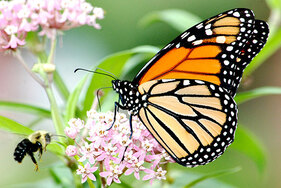 Written by: Margaret Hartman (M.S. student, Lamp Lab) and Demian Nunez (M.S. student, Hooks Lab) In recent years the public has become increasingly aware of the devastating impact humans are having on wildlife across the globe. Insect declines have received a lot of attention in the news lately with stories about the decline of pollinators inspiring people across the country to find ways to “save the bees,” including planting flowers in their yards, and some state and local governments are even taking steps to restrict or ban certain pesticides that are known to be harmful to pollinators. While honeybees (Apis mellifera) are among the most recognizable and charismatic of these pollinators, the real crisis is the even greater loss of native pollinator abundance and diversity across much of North America and other parts of the world. But pesticide usage isn’t the only factor contributing to the loss of our native bees and other insects. Diseases, parasites, and especially habitat loss have all contributed to native bee decline, and efforts to maintain and restore the health of our pollinator ecosystems will require a broad approach to making our expanding urban landscapes suitable for preserving our pollinator communities. 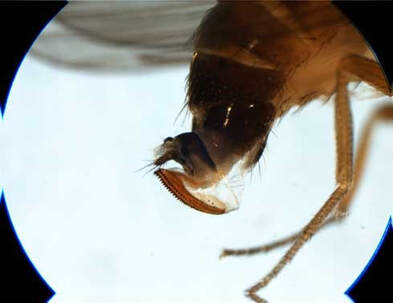 Fig. 1. SWD Large and serrated ovipositor (photo by Martin Hauser) Fig. 1. SWD Large and serrated ovipositor (photo by Martin Hauser) written by: Elizabeth Dabek, MS student, Hooks and Shrewsbury lab & Serhat Solmaz, MS student, vanEngelsdorp Lab The Spotted-wing Drosophila (SWD) is an invasive pest native to Southeast Asia. Since it was first detected in 2008 in California, the fly has rapidly become widespread throughout North America. Unlike other common drosophila species breeding on rotting fruits, SWD female has a large and serrated ovipositor (Fig. 1) that enables it to lay eggs inside ripe and fresh fruits. As the fruit ripens, often after harvest, damage caused by SWD (dimples and craters on the skin of the fruit) becomes visible (Fig. 2). SWD is highly polyphagous; being able to oviposit and/or reproduce in various cultivated and wild fruits. Its fast development and high reproductive potential can lead to explosive population increases and significant economic losses to crops. Economic losses from SWD in the western US for raspberries, blackberries, blueberries, strawberries, and cherries are estimated to be up to $500 million annually1. Current control programs rely heavily on insecticides that target adult flies in commercial crops. Because non-crop habitats can act as a reservoir for the fly’s reinvasion into treated crops, area-wide IPM strategies such as biological control that reduce population densities at the landscape level need to be developed for such a highly mobile and polyphagous pest. |
Categories
All
Archives
March 2024
|
Department of Entomology
University of Maryland
4112 Plant Sciences Building
College Park, MD 20742-4454
USA
Telephone: 301.405.3911
Fax: 301.314.9290
University of Maryland
4112 Plant Sciences Building
College Park, MD 20742-4454
USA
Telephone: 301.405.3911
Fax: 301.314.9290

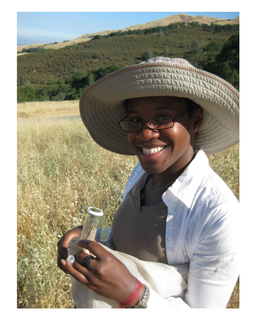
 RSS Feed
RSS Feed




